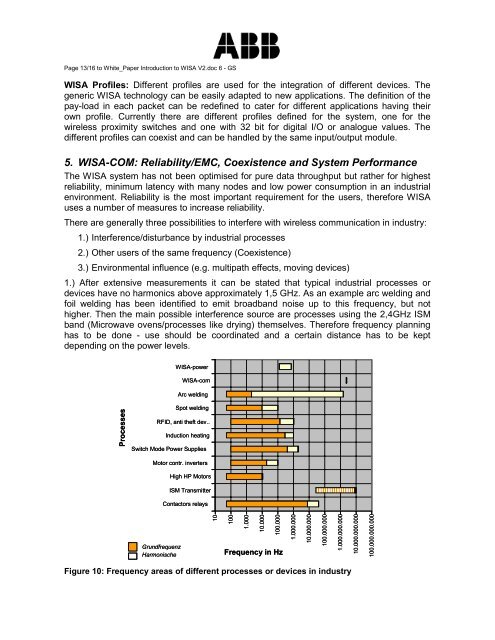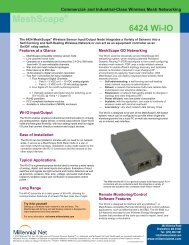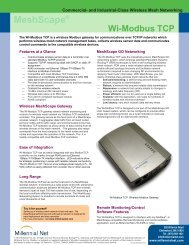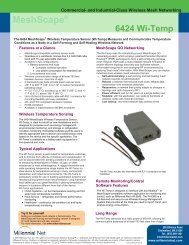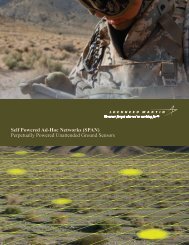Introduction to WISA - Millennial Net
Introduction to WISA - Millennial Net
Introduction to WISA - Millennial Net
- No tags were found...
Create successful ePaper yourself
Turn your PDF publications into a flip-book with our unique Google optimized e-Paper software.
Page 13/16 <strong>to</strong> White_Paper <strong>Introduction</strong> <strong>to</strong> <strong>WISA</strong> V2.doc 6 - GS<strong>WISA</strong> Profiles: Different profiles are used for the integration of different devices. Thegeneric <strong>WISA</strong> technology can be easily adapted <strong>to</strong> new applications. The definition of thepay-load in each packet can be redefined <strong>to</strong> cater for different applications having theirown profile. Currently there are different profiles defined for the system, one for thewireless proximity switches and one with 32 bit for digital I/O or analogue values. Thedifferent profiles can coexist and can be handled by the same input/output module.5. <strong>WISA</strong>-COM: Reliability/EMC, Coexistence and System PerformanceThe <strong>WISA</strong> system has not been optimised for pure data throughput but rather for highestreliability, minimum latency with many nodes and low power consumption in an industrialenvironment. Reliability is the most important requirement for the users, therefore <strong>WISA</strong>uses a number of measures <strong>to</strong> increase reliability.There are generally three possibilities <strong>to</strong> interfere with wireless communication in industry:1.) Interference/disturbance by industrial processes2.) Other users of the same frequency (Coexistence)3.) Environmental influence (e.g. multipath effects, moving devices)1.) After extensive measurements it can be stated that typical industrial processes ordevices have no harmonics above approximately 1,5 GHz. As an example arc welding andfoil welding has been identified <strong>to</strong> emit broadband noise up <strong>to</strong> this frequency, but nothigher. Then the main possible interference source are processes using the 2,4GHz ISMband (Microwave ovens/processes like drying) themselves. Therefore frequency planninghas <strong>to</strong> be done - use should be coordinated and a certain distance has <strong>to</strong> be keptdepending on the power levels.<strong>WISA</strong>-power<strong>WISA</strong>-comArc weldingProcessesSpot weldingRFID, anti theft dev..Induction heatingSwitch Mode Power SuppliesMo<strong>to</strong>r contr. invertersHigh HP Mo<strong>to</strong>rsISM TransmitterContac<strong>to</strong>rs relaysGrundfrequenzHarmonische101001.00010.000100.000Frequency in Hz1.000.00010.000.000100.000.0001.000.000.00010.000.000.000100.000.000.000Figure 10: Frequency areas of different processes or devices in industry


